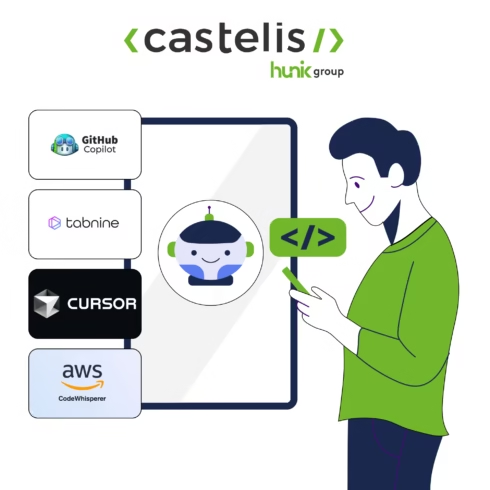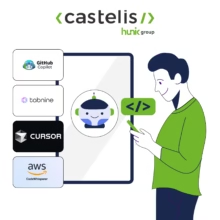
Comparison of AI-assisted coding assistants and IDEs
The rise of AI coding assistants is profoundly transforming the way developers approach their projects. These tools allow you to write code faster, correct errors automatically, and improve collaboration in technical teams. But with the diversity of options available, how do you choose the right assistant for your project needs and the team’s level of technical expertise? This comprehensive guide compares the leading solutions on the market to help you make the best decision. At Castelis, we have tested these tools to be able to compare them and provide initial feedback.
How to choose the right coding assistant?
1. Code completion features
The primary goal of an AI assistant is to streamline the development process. Some tools offer basic word-for-word suggestions, while others generate entire blocks of code adapted to the context of the project.
- Type of suggestions: Does the tool offer full suggestions or just individual line completions? Simple completion (word-for-word) vs. advanced completion (whole code block, complete structures).
- Accuracy and relevance: Quality of suggestions based on context.
- Multilingual support: Compatibility with multiple programming languages (Python, Java, JavaScript, etc.).
- Ability to generate unit tests and refactoring: Can it suggest tests and improve existing code?
Comparison of AI-assisted IDEs on these criteria:
- GitHub Copilot: Able to offer complete code structures and context-specific solutions, it is particularly effective for quickly generating boilerplate code and automating recurring tasks.
- Tabnine: Offers precise and customizable completion, with the ability to run locally, a considerable advantage for teams concerned about the confidentiality of their code.
- Cursor: Adds an interactive dimension with an integrated AI chat, allowing developers to ask questions about their code and get detailed explanations.
- Windsurf: Designed to go further by generating code autonomously and proposing intelligent corrections based on the overall context of the project.
- Amazon CodeWhisperer: Specially optimized for AWS environments, it excels when it comes to integrating Amazon cloud services.
- Replit Ghostwriter: Ideal for beginner developers or those working in teams, with a smooth integration into the Replit IDE and an efficient collaborative mode.
💡 Concrete example: When developing a REST API in Node.js, GitHub Copilot allowed us to automate the initial configuration of routes and middleware, reducing the setup time from several hours to a few minutes.
2. Integration and Compatibility with IDEs
- IDE Compatibility: Is this AI assistant compatible with your favorite development environment? Does it work with VS Code, JetBrains, Vim, IntelliJ, etc.?
- Direct integration or via extensions: Is it a complete IDE or a plugin?
Concretely, the main current coding assistants adopt complementary positions:
-
- GitHub Copilot: Native for VS Code and JetBrains, it integrates perfectly into these IDEs.
- Tabnine: Works with VS Code, JetBrains, Sublime Text, and other popular editors.
- Cursor: Offers an enriched experience based on VS Code, but with advanced AI features.
- Windsurf: Offers a complete IDE with native AI.
- Amazon CodeWhisperer: Works mainly with Cloud9 and the AWS environment.
- Replit Ghostwriter: 100% browser-based, perfect for coding on the move or in collaboration.
💡 Concrete example: On a project requiring AWS microservices, CodeWhisperer provided us with precise suggestions adapted to Lambda and S3 services, offering a real time saving compared to a generalist AI assistant.
Another situation: Cursor, based on VS Code, allows us to benefit from an integrated environment with native AI functionalities, while GitHub Copilot integrates as a plugin, offering flexibility for those who use several editors, as is often the case on our projects.
3. AI Model Used and Performance
- Type of model: Based on Codex (GPT), proprietary models (IntelliCode), or open-source. Capability of contextual understanding: Level of contextualization in relation to the overall project or individual file.
- Response time and fluidity: Speed of suggestions and impact on productivity.
Comparative case: In a cloud-native project using AWS Lambda and S3, Amazon CodeWhisperer offers better integration than Copilot because it is specifically designed to understand AWS services and provide tailored suggestions.
4. User Experience and Interface
- Ergonomics: Ease of use, intuitive interface.
- Natural language commands: Ability to describe a task in natural language to generate code.
- Suggestion customization: Can recommendations be adjusted or certain types of suggestions disabled?
Ergonomics and ease of use play a key role in the adoption of an AI assistant.
- GitHub Copilot: Minimalist and intuitive interface, integrated with supported IDEs.
- Cursor: Advanced ergonomics with an integrated AI chat for natural language interaction.
- Windsurf: Complete experience with advanced features requiring a slight learning phase.
- Replit Ghostwriter: Maximum simplicity and accessibility for new developers.
💡 Concrete example: During a team project, Cursor facilitated the understanding and improvement of the code thanks to its interactive interface allowing questions to be asked in real time to the AI.
Tested by a curious intern: using Replit Ghostwriter, he was able to easily start a web portfolio project thanks to a minimalist web interface and simplified suggestions.
5. Collaboration Capabilities and Generative AI
- Real-time collaboration: AI-assisted pair programming features.
- Assisted code review integration: Automatic error detection and code improvement.
Example: During a hackathon, Replit Ghostwriter allows several developers to collaborate live on the same project thanks to its real-time code sharing.
6. Security and Data Protection
- Code confidentiality: Is your code protected when used in the tool? Is the code sent to third-party servers?
- Offline mode: Does it work without an internet connection?
- Compliance: Compliance with security standards (GDPR, HIPAA, etc.).
Working with an AI assistant involves sending code for analysis. This raises the question of data protection.
- Tabnine: Works in local mode, ensuring that your code never leaves your machine.
- Windsurf: Ensures local execution without data transfer.
- GitHub Copilot, Cursor, CodeWhisperer: Require a connection to cloud servers to process suggestions.
- Replit Ghostwriter: The code is stored on Replit servers.
💡 Concrete example: In a project to develop an internal tool containing sensitive information, we favored TabNine in local mode in order to guarantee data confidentiality while taking advantage of AI suggestions.
7. Pricing and Business Model
- Free vs. paid version: Are there free features?
- Price per user or per project: Monthly or annual billing?
- GitHub Copilot: Monthly or annual paid subscription.
Concretely, on the tools we compare in this article, what does it give?
- Tabnine: Free version with basic features, pro version for full access.
- Cursor: Free with advanced paid options.
- Windsurf: Free for basic use, with a premium version for businesses.
- Amazon CodeWhisperer: Free for AWS users, pro version available.
- Replit Ghostwriter: Free version with a paid plan for more features.
8. Community and Technical Support
- Documentation and tutorials: Quality of learning resources.
- Technical support: Responsiveness and availability of support in case of problems.
- Active community: Open-source contributions or help forums.
Example: GitHub Copilot benefits from comprehensive documentation and a large GitHub community, making learning easier for new users.
9. Scalability and Advanced Features
- Adaptation to large projects: Does it manage complex projects with many files well?
- Advanced Refactoring Support: Can it restructure code automatically?
Here is an updated version of the comparison table including GitHub Copilot, Tabnine, Cursor, Windsurf, Amazon CodeWhisperer, and Replit Ghostwriter, along with an adapted conclusion.
Comparing AI-Assisted IDEs: GitHub Copilot, Tabnine, Cursor, Windsurf, Amazon CodeWhisperer, and Replit Ghostwriter
| Criteria | GitHub Copilot | Tabnine | Cursor | Windsurf | Amazon CodeWhisperer | Replit Ghostwriter |
| Code Completion | Advanced completion based on GPT-4, offers entire blocks of code ✔️ | Basic to advanced, word-for-word completion, less powerful ❌ | Advanced completion with built-in AI chat ✔️ | Advanced completion with agentic AI and autonomous code generation ✔️ | Advanced completion, but limited to AWS cloud ❌ | Built-in completion and AI chat, good for beginners ✔️ |
| IDE Integration | Native integration with VS Code and JetBrains ✔️ | Compatible with VS Code and JetBrains ✔️ | Based on VS Code, but with native AI features ✔️ | Clean, all-in-one complete IDE ✔️ | Direct integration with AWS Cloud IDE ❌ | Browser-based IDE, online access only ❌ |
| AI model | Based on Codex (GPT-4) ✔️ | Proprietary model, less advanced than GPT-4 ❌ | Based on Codex (GPT-4) ✔️ | Hybrid model: proprietary + open source ✔️ | Proprietary CodeGPT model, AWS optimized ✔️ | Limited, less advanced proprietary model ❌ |
| Pricing | Paid monthly, full access to features ✔️ | Free with pro version, good compromise ✔️ | Free with pro version, flexible ✔️ | Free with paid options for businesses ✔️ | Free for AWS, pro version with more access ✔️ | Paid in pro version, full access ✔️ |
| Privacy and Security | Shared Cloud Data ❌ | Local mode available, enhanced privacy ✔️ | Shared Cloud Data ❌ | Local mode available, no cloud transfer ✔️ | Data stored on the secure AWS cloud ❌ | Data stored on the cloud Replit ❌ |
| Personalization of suggestions | Limited customization of suggestions ❌ | Manually configurable suggestions ✔️ | Advanced customization via contextual chat ✔️ | Highly flexible customization with automation ✔️ | Very basic customization ❌ | Limited customization of suggestions ❌ |
| Multilingual Capability | Supports multiple languages (multilingual) ✔️ | Supports multiple languages (multilingual) ✔️ | Multilingual support ✔️ | Extensive multilingual support ✔️ | Multilingual support ✔️ | Multilingual support ✔️ |
| Collaboration Features | No collaboration features ❌ | No collaboration features ❌ | Collaboration Features with AI Chat ✔️ | Advanced collaboration with assisted peer programming ✔️ | No collaboration or peer programming❌ | Advanced collaboration with project sharing ✔️ |
| Data Security | Data is shared with OpenAI ❌ | Private mode possible with local version ✔️ | Data is shared with OpenAI ❌ | Private mode, total data protection ✔️ | Secure data in the AWS ecosystem ✔️ | Data shared via Replit ❌ |
| User Experience | Simple and clean interface, easy to use ✔️ | Clear and minimalist interface ✔️ | Advanced and developer-optimized ergonomics ✔️ | Advanced interface, but requires more learning ❌ | Optimized integration for AWS services ✔️ | Web simplicity, ideal for education ✔️ |
Summary of the specifics of these AI-powered coding assistants and IDEs
GitHub Copilot
- Key feature: Advanced code completion based on the Codex model (GPT-4), offers contextual suggestions on entire blocks of code.
- Use case: Ideal for developers using environments like VS Code or JetBrains who want to speed up writing code across a variety of projects.
- Notable difference: Less control over customizing suggestions and requires cloud access to run.
Tabnine
- Key feature: Verbatim and advanced code completion, with a proprietary model and local mode available.
- Use case: Suitable for privacy-conscious developers who want to use an offline model.
- Notable difference: Less advanced than Copilot on complex suggestions but more flexible in terms of security.
Cursor
- Key feature: VS Code-based IDE with advanced completion and built-in AI chat for direct interaction with the assistant.
- Use case: Best for developers who want an AI assistant with detailed suggestions and the ability to explain portions of code.
- Notable difference: More conversational approach, but also cloud-dependent.
Windsurf
- Key feature: Full-featured IDE with agentic AI, capable of autonomously generating code and fixing errors.
- Use case: Recommended for advanced developers working on complex projects that require a flexible assistant.
- Notable difference: High flexibility and local execution possible, but requires a longer learning curve.
Amazon CodeWhisperer
- Key feature: Advanced completion powered by CodeGPT, seamlessly integrated into the AWS environment.
- Use case: Best for AWS developers who want to automate code generation in cloud-native projects.
- Notable difference: Limited to the AWS ecosystem, but offers contextual suggestions optimized for AWS services.
Replit Ghostwriter
- Key feature: Code completion and online AI assistance in the Replit IDE, with collaboration capabilities.
- Use case: Ideal for beginner developers and teaching coding thanks to its simplicity.
- Notable difference: Less advanced than Copilot or Cursor for complex projects but excellent for online collaboration.
Conclusion: Which tool should you choose according to your use?
- For general and advanced use: GitHub Copilot is an excellent choice for developers looking for a powerful and versatile assistant.
- For maximum confidentiality: Tabnine in local mode is recommended for companies sensitive to security issues.
- For an environment directly integrating AI: Cursor or Windsurf offer advanced features within a dedicated IDE.
- For AWS projects: Amazon CodeWhisperer provides precise contextual suggestions for cloud services.
- For online collaboration and development: Replit Ghostwriter is ideal for distributed teams and beginner developers.
👉 Our recommendation: Test several solutions and choose the one that best integrates with your workflow. AI is a powerful tool, but it must be adapted to the specificities of your project and your technical environment.



